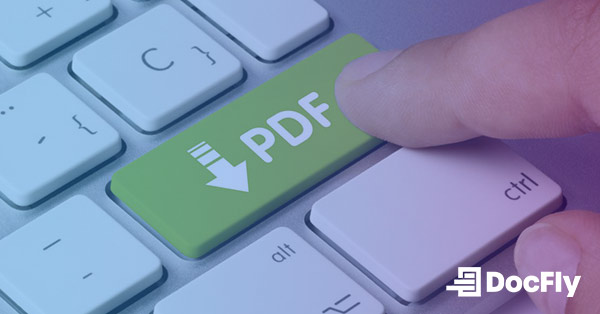The Top 5 Advantages of PDF
PDF files, or Portable Document Format files, have become the unsung heroes of digital documentation. They're like the Swiss Army knife of file formats—adaptable, reliable, and useful in more ways than meets the eye. Think of a PDF as a snapshot of your document, freezing it in time while keeping everything intact, from text and images to formatting and fonts. In a world with many file types, PDFs stand out for their versatility and ease of use. Let's look deeper into why choosing PDFs over other document formats might be the smartest move for simplifying your digital life.

Source: Unsplash/Jess Bailey
Table of Contents
Why Choose PDFs Over Other Documents?
Relative to many other file types, PDFs emerge as a practical choice for several compelling reasons. Unlike other formats, PDFs offer a consistent and unalterable display across various devices and operating systems. This universal compatibility ensures that your document looks the same whether you're opening it on a Windows PC, a Mac, or a mobile device. Furthermore, PDFs are non-editable by default, safeguarding the integrity of your content. This characteristic proves invaluable when you want to share important information without the risk of unintended changes. Moreover, PDFs are easily viewable through web browsers, eliminating the need for specific software installations. In the following sections, we'll explore the distinct advantages that make PDFs a standout option for your digital documentation needs.
Advantages of Having a Document in PDF Format
Advantage 1: Formatting Consistency
PDFs excel in maintaining consistent formatting across different devices and platforms. Whether your document contains complex layouts, fonts, or images, a PDF document ensures that the visual integrity remains intact. This makes PDFs particularly useful for professional documents, presentations, and any content where visual precision is crucial.
Advantage 2: Security and Access Control
One of the standout features of PDFs is their security options. PDFs allow you to set password protection, restricting access to sensitive information. Additionally, you can implement various levels of permissions, defining who can view, edit, or print the document. This enables read-only PDFs, for example. This level of control ensures that your data remains confidential and only accessible to those with the proper authorization. Finally, applying digital signatures to a PDF guarantees the contents of the file have not been altered.
Advantage 3: Compact File Size
PDFs offer an efficient way to compress files without compromising quality. This is especially beneficial when sharing docs online or via email, as it reduces the file size and speeds up the transfer process. The compact nature of PDFs makes them ideal for archiving large volumes of information without taking up excessive storage space.
Advantage 4: Interactive Elements
PDFs support interactive elements such as hyperlinks, bookmarks, and multimedia content. This makes them a versatile choice for creating interactive documents, e-books, or presentations. Whether you're adding clickable links for easy navigation or embedding videos for enhanced engagement, PDFs provide a platform for dynamic and engaging content.
Advantage 5: Print-Ready Documents
PDFs are inherently print-ready, ensuring that your document will appear as intended when printed. This is particularly advantageous for projects like brochures, posters, or any material where the physical presentation is a key consideration. PDFs eliminate the uncertainty associated with printing by preserving the layout, colors, and fonts of your document.
The advantages of using PDFs extend far beyond these examples, making them a versatile and reliable choice for various document needs. In the next section, we'll address some common challenges faced when working with PDFs.
Common Challenges Faced When Using PDF Format for Documents
While PDFs offer many benefits, like any technology, they come with their own set of challenges. Understanding these common issues will empower you to navigate them effectively.
Compatibility with Editing Software
One notable challenge is the compatibility between PDFs and editing software. While PDFs are designed to preserve document integrity, editing them can sometimes be cumbersome. Users may encounter difficulties when attempting to make significant changes to the content or structure of a PDF. This is unlike typical Word documents, which are relatively easy to edit. However, various PDF editing tools and software solutions are available to help edit a PDF, allowing users to modify PDFs with greater ease.
Text Extraction and Reusability
Extracting text or data from a PDF can be challenging, especially if the document is scanned or contains complex formatting. This limitation can impede the reusability of content for other projects. This is where using a PDF converter that can convert PDF is useful. More specifically, consider using Optical Character Recognition (OCR) tools that can convert scanned images or PDFs into editable and searchable text, enhancing the document's overall usability.
Limited Mobile Editing Capabilities
While viewing PDFs on mobile devices is seamless, editing capabilities on these platforms may be limited. Users might find it challenging to make extensive edits or annotations using mobile applications. It's essential to be aware of these limitations and choose the appropriate platform based on your editing requirements.
File Size for Large Documents
Despite their efficiency in compressing files, large and graphics-heavy documents may still pose challenges in terms of file size. Sharing or uploading sizable PDFs can be time-consuming, especially in situations with limited bandwidth. To address this, consider optimizing your PDFs for web viewing or use file compression tools to reduce the overall size without compromising quality. Note that PDFs can be compressed using a PDF editor with a compress PDF feature such as DocFly.
Accessibility Concerns
Ensuring that PDFs are accessible to individuals with disabilities can be a challenge. PDFs may present barriers to those reading using screen readers or other assistive technologies. To enhance accessibility, incorporate proper document structuring, alternative text for images, and other accessibility features when creating PDFs. Also consider using a PDF reader that works well with screen readers.
Navigating these challenges will enable you to harness the full potential of PDFs for your document needs. In the concluding section, we'll recap the key advantages of using PDFs while acknowledging these challenges, providing a balanced perspective on this widely adopted file format.
Conclusion
Among many choices, the PDF stands out, offering many advantages that cater to diverse needs. From maintaining consistent formatting to ensuring security and access control, PDFs provide a reliable solution for creating, sharing, and preserving documents. The compact file size, support for interactive elements, and print-ready nature further contribute to their versatility.
However, as with any technology, PDFs aren't without their challenges. Compatibility issues with editing software, limitations in mobile editing capabilities, and considerations for accessibility are aspects that users should be mindful of when working with PDFs. Despite these challenges, the adaptability and widespread acceptance of PDFs make them an indispensable tool in the digital toolbox.
Understanding the strengths and limitations of PDFs allows users to make informed decisions based on their specific requirements. Whether you're crafting a professional report, sharing interactive content, or archiving important information, PDFs offer a robust solution.
In conclusion, the advantages of PDFs, such as formatting consistency, security features, and compact file size, position them as a preferred choice for various document needs. By navigating the challenges with awareness and utilizing available tools, users can harness the full potential of PDFs. As technology continues to evolve, PDFs remain a steadfast and adaptable format, simplifying the complexities of digital documents for users across the globe.

Emily Shaw is the founder of DocFly. As a software developer, she built the service from scratch and is responsible for its operations and continued growth. Previously, she studied engineering at the University of Hong Kong and mathematics at the University of Manchester.
Loved what you just read? Share it!
Related posts you might enjoy
What is PDF Format?

How to Password Protect a PDF - and Why You Should



